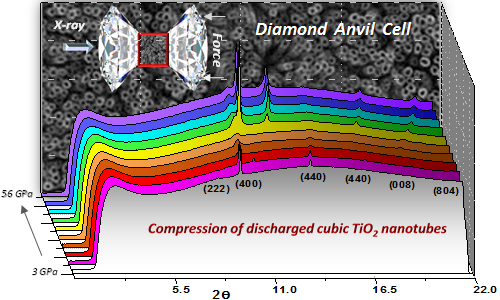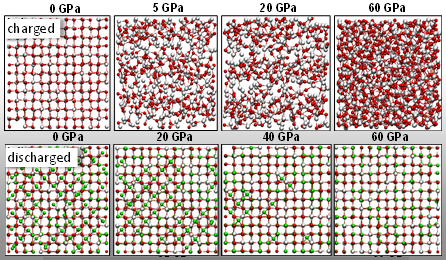Compositional tuning of structural stability via vacancy filling mechanism

(Phys.org)—Researchers in the Center for Nanoscale Materials' NanoBio Interfaces and Theory & Modeling groups, together with researchers from the University of Chicago, found an integrated experimental and computational approach that demonstrates a lithium-ion composition-dependent stability of vacancy-enriched cubic TiO2 anode subjected to high pressures in the GPa range. A unique atomistic scale response mechanism was found in which cation intercalation induces remarkable stability of defective materials under applied stress. These findings can potentially benefit the optimization of battery electrodes while demonstrating that high cationic vacancy-containing cubic materials can better accommodate electrode stress, leading to improved long-term stability for lithium-ion battery operation.
Battery electrodes experience large atomic rearrangements and high localized stress during the intercalation-deintercalation process. The theoretically predicted vacancy filling mechanism suggests that enhanced stability of cubic TiO2 electrodes is a consequence of a pressure-initiated ordering at the sites subjected to the highest local stress. Enhanced structural stability was found to arise from a "vacancy filling mechanism" in which an applied pressure drives interstitial lithium ions to vacancy sites in the oxide interior.

Using CNM's expertise in the design of nano-architectured energy materials in conjunction with molecular dynamics simulations, in addition to synchrotron measurements at the Advanced Photon Source, metastable materials were established as a platform for creating self-assembling and self-improving batteries that preserve superior capacity and power over prolonged cycling. Electrodes that naturally choose and optimize their structure with repeated cycling can achieve theoretical performance. Electronically interconnected nanoporosity enables full participation of every electrode atom in achieving theoretical capacity, while the short diffusion lengths of transporting ions (lithium, sodium, or magnesium) enables exceptionally fast charging.
The crystalline-to-amorphous phase transition pressure increases monotonically with lithium concentration (from ~17.5 GPa for delithiated to no phase transition for fully lithiated cubic titania up to 60 GPa). The associated enhancement in structural stability is postulated to arise from a vacancy filling mechanism in which an applied pressure drives interstitial lithium ions to vacancy sites in the oxide interior. The findings suggests that, although surprisingly stable, a c-TiO2 nanotube electrode is most vulnerable in the discharged state (delithiated). Increased lithium concentration gives rise to a vacancy filling mechanism under the applied pressure that enhances the structural stability of cubic TiO2.
In battery electrodes, large atomic rearrangements and high stress are expected at the highest lithium concentration gradient. The observed vacancy filling mechanism suggests that enhanced stability of c-TiO2 electrodes is a consequence of a pressure-initiated ordering at the sites subjected to the highest local stress. These findings could benefit the optimization of battery electrodes and show that high cationic vacancy content in cubic materials assists in accommodating electrode stress and improves their long-term stability for lithium-ion battery operation.
More information: H. Xiong et al., Compositional Tuning of Structural Stability of Lithiated Cubic Titania via Vacancy Filling Mechanism under High Pressure, Phys. Rev. Lett., in press (2013).
Journal information: Physical Review Letters
Provided by Argonne National Laboratory




















